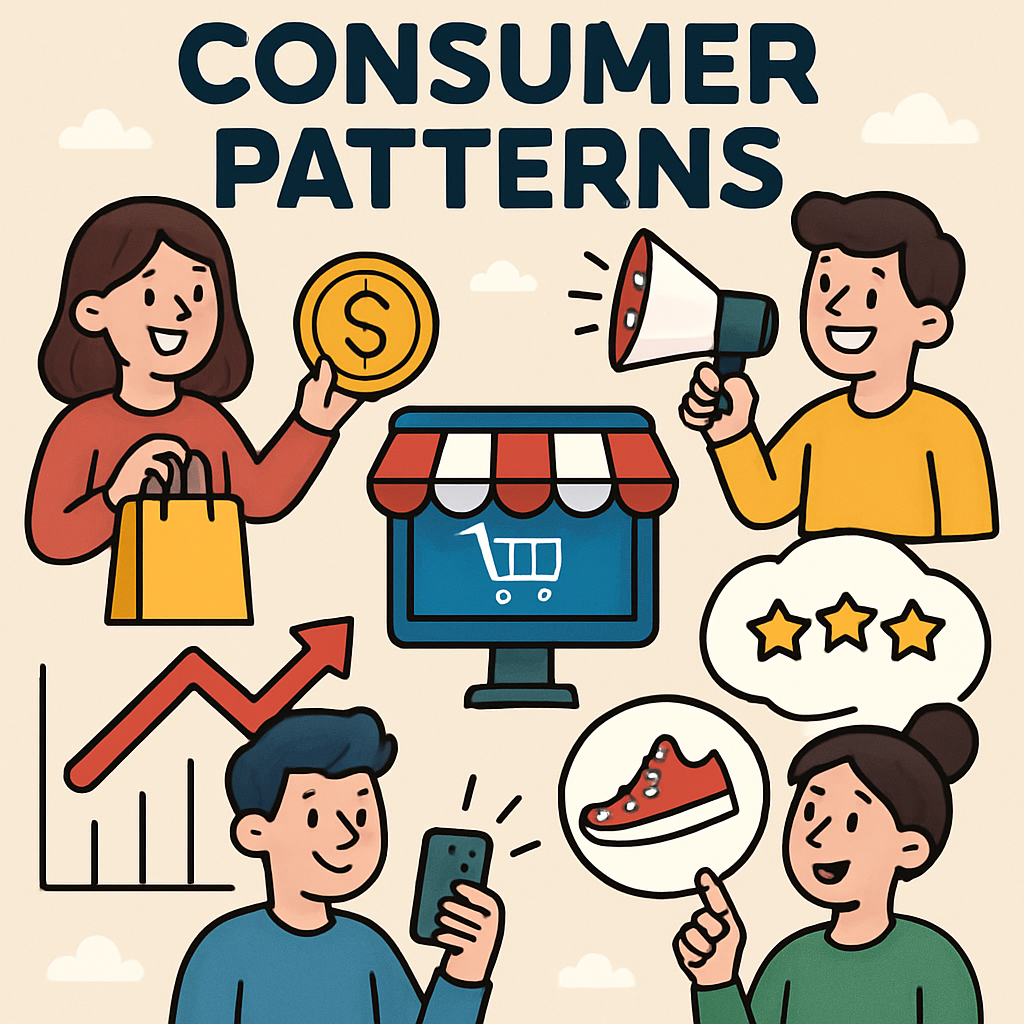 What Are Consumer Patterns Online?
What Are Consumer Patterns Online?
In this lesson, you will explore consumer patterns online. These refer to the methods companies use to monitor your internet activities, such as your searches, clicks, and purchases. They utilise this information to promote products to you. This is similar to how a shopkeeper might observe that you prefer certain items and then highlight them during your next visit.
Online, your behaviours are tracked to build a profile of your potential interests. This enables companies to generate revenue by displaying advertisements that align with your preferences. However, it is essential to understand these processes to make informed decisions and avoid being persuaded to purchase unnecessary items.
By the end of this lesson, you will comprehend how your online actions affect the content you encounter and how to become an informed digital consumer.
 Targeted Ads and How They Follow You Around
Targeted Ads and How They Follow You Around
In this step, you will explore the concept of targeted advertising, a widespread practice across the internet. Targeted advertisements are carefully selected to appear based on your online activities, including your searches, clicks, and purchases.
Let us consider a practical scenario: Suppose you search for a pair of trainers on an online shopping website. Subsequently, you may observe advertisements for similar trainers appearing on various other platforms, such as social media sites, news websites, or even within online games. This phenomenon occurs because companies collect and share data regarding your browsing behaviour to present relevant advertisements. This method is referred to as retargeting, whereby the internet 'remembers' your interests and displays reminders to encourage you to make a purchase.
Targeted advertisements can offer benefits by presenting products that align with your needs or preferences, potentially saving you time in discovering suitable items. However, they can also seem intrusive, creating the impression that you are being followed online. Furthermore, they might prompt impulsive buying decisions without sufficient consideration of whether the item is truly necessary or affordable.
To gain a deeper understanding, let us break down the process:
It is essential to recognise these practices in order to make informed decisions about your online privacy and spending habits. Being aware allows you to evaluate advertisements critically and consider alternatives, such as adjusting your browser settings to limit tracking.
In addition, targeted ads often rely on algorithms that predict what you might like based on past behaviour. For instance, if you frequently view sports-related content, you may see more ads for athletic wear or equipment. While this personalisation can enhance your online experience, it is important to remain vigilant and question whether the suggestions are genuinely helpful or merely designed to influence your choices.
 Cookies and Basic Tracking
Cookies and Basic Tracking
Cookies are small pieces of data that websites store on your device. They remember information such as what you have clicked on or items added to your shopping cart.
In simple terms, cookies enable websites to track your online activities so they can display personalised content. For example, if you visit a gaming site, cookies might record that and later show you advertisements for games. You can often choose to accept or reject them when a site prompts you.
Tracking involves companies monitoring your path across the web to understand your habits. This process collects data to predict what you might purchase next.
 Influencer Marketing and Trust
Influencer Marketing and Trust
Influencer marketing involves individuals with large followings on social media platforms, such as YouTube or TikTok, who are paid by companies to promote products or services. These influencers might create content where they endorse an item, for example, by stating that a particular smartphone is excellent and recommending it to their audience. However, it is essential to consider whether such endorsements are based on genuine opinions or primarily driven by financial compensation.
When evaluating influencer content, ask yourself the following questions:
Understanding these aspects helps you build trust wisely. While influencers can provide useful recommendations and introduce you to new products, it is important to remain critical and not make purchasing decisions solely based on their promotions. Always research the product independently, read reviews from multiple sources, and consider your own needs before buying.
By developing these skills, you can navigate influencer marketing more effectively and avoid being unduly influenced by commercial tactics.
 Personalised Content on Social Media Platforms
Personalised Content on Social Media Platforms
In this step, you will explore the concept of personalised content on social media applications, such as TikTok or Instagram. These platforms use features like the 'For You' page to display videos and posts that are specifically tailored to your interests. This tailoring is based on data collected from your previous interactions, including the videos you have watched, liked, or shared.
Personalised content is generated through algorithms that analyse your behaviour to predict what you might enjoy next. For instance, if you frequently view content related to sports, the platform will prioritise similar videos in your feed. This process creates a customised experience designed to keep you engaged for longer periods.
While this can be enjoyable and convenient, as it delivers content that aligns with your preferences, there are potential drawbacks. It may create an 'echo chamber' effect, where you are primarily exposed to similar ideas and viewpoints, limiting your access to diverse perspectives. Additionally, personalised feeds often integrate advertisements that blend seamlessly with regular content, making it challenging to distinguish between genuine posts and promotional material.
To better understand this, consider the following key points:
By recognising these elements, you can become more aware of how social media shapes your online experience and make informed choices about your consumption habits.